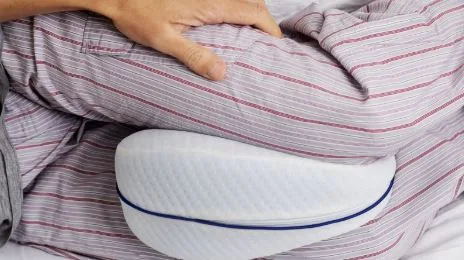The Science Behind Why Knee Pillows Improve Sleep Quality for Side Sleepers
Side sleeping is one of the most common sleeping positions, often recommended by sleep specialists for its potential benefits in reducing snoring, improving breathing, and supporting spinal alignment. However, for all its advantages, side sleeping also brings unique challenges that can affect overall sleep quality. The most common issues are hip and lower back strain, joint pressure, and misalignment of the spine. Without proper support, the knees can rest directly against each other, leading to discomfort from joint pressure and even misalignment of the hips. Over time, this can cause muscle tension, stiffness, or pain that disrupts sleep cycles.
This is where a knee pillow for side sleepers becomes a game-changer. By placing a pillow between the knees, the hips remain more level, the spine stays in a neutral position, and pressure on the knees is reduced. This small adjustment addresses many of the mechanical issues that side sleepers face. But the improvement isn’t just about physical comfort—it’s about creating an environment that allows the body to relax fully and stay in restorative stages of sleep longer. To understand why knee pillows make such a difference, we first need to examine the science of spinal alignment, muscle tension, and the way the nervous system responds to physical comfort during sleep.
The Biomechanics of Spinal Alignment
When you lie on your side, your body is naturally subjected to gravitational pull that can cause the spine to curve unnaturally if unsupported. In particular, the pelvis can tilt or rotate, leading to an uneven distribution of weight along the lower back and hips. This misalignment puts strain on muscles and ligaments, especially in the lumbar region. Over time, this strain can cause inflammation, stiffness, and morning soreness that accumulates into chronic discomfort.
A knee pillow for side sleepers works to counteract these biomechanical challenges by filling the space between the knees, thereby preventing the upper leg from pulling the spine out of alignment. This improved posture helps muscles stay relaxed instead of contracting to compensate for the misalignment. From a musculoskeletal perspective, maintaining neutral spine alignment is critical not only for immediate comfort but also for reducing the risk of developing chronic conditions such as sciatica, hip bursitis, or even degenerative disc problems. When the lower back is supported in this way, the body’s natural curves remain in place, and the pressure on discs and joints is minimized.
In addition to physical structure, alignment impacts how muscles function during sleep. Muscles that are chronically tensed to stabilize an unsupported spine can reduce blood flow, limiting the body’s ability to repair and restore tissues overnight. By stabilizing the hips and pelvis, a knee pillow reduces these unnecessary muscle contractions, allowing for deeper relaxation and better recovery during sleep.
Pressure Relief and Circulation Benefits
One of the primary functions of a knee pillow for side sleepers is to redistribute weight more evenly, which can significantly reduce pressure points. When you sleep without a knee pillow, the contact between your knees creates a small but constant pressure that can become uncomfortable over hours. This pressure is not just a matter of comfort—it also impacts circulation. Restricted blood flow can lead to tingling sensations, numbness, or restlessness that interrupts the body’s ability to maintain deep sleep cycles.
By placing a cushion between the knees, the pressure is absorbed and dispersed over a wider surface area, preventing the sharp contact that can trigger micro-awakenings throughout the night. The improved circulation also enhances oxygen delivery to muscles, which is particularly important during the body’s restorative sleep stages, such as slow-wave sleep. Better circulation supports the removal of metabolic waste products from muscles, further aiding in recovery.
There’s also a neurological aspect to pressure relief. When the skin and joints experience less pressure, nerve endings send fewer distress signals to the brain. This means the brain can remain in deeper, more restful stages of sleep without being prompted to adjust position as frequently. Over the course of a night, fewer awakenings translate into more consolidated and restorative rest, which directly contributes to feeling more refreshed in the morning.
Impact on Joint Health and Muscle Recovery
The benefits of using a knee pillow for side sleepers extend beyond nightly comfort—they can also contribute to long-term joint health. When the knees press against each other without cushioning, the cartilage in the joints may experience unnecessary wear over time. While this is less intense than high-impact activities, the prolonged and repetitive nature of nightly contact can contribute to irritation in people with preexisting joint issues, such as arthritis. A knee pillow acts as a protective barrier, reducing friction and preserving joint integrity.
For athletes or physically active individuals, a knee pillow can also play a role in muscle recovery. Sleep is when most of the body’s repair processes take place, driven by the release of growth hormone and the activation of tissue-repair pathways. If muscles are under strain or misaligned during this period, recovery efficiency can be compromised. Supporting proper hip and spinal alignment helps ensure that recovery energy is directed toward repairing microtears in muscle fibers rather than counteracting strain caused by poor sleeping posture.
There’s also evidence suggesting that improved sleep posture can help alleviate certain types of inflammation. Misalignment can place uneven pressure on joints and surrounding tissues, creating localized inflammation that slows recovery. By preventing these stress points, a knee pillow helps maintain a more balanced musculoskeletal environment, supporting both comfort and long-term mobility.
Psychological and Sleep Cycle Effects
Sleep quality is not determined by physical comfort alone; the brain plays a crucial role in maintaining restful and restorative sleep. Discomfort, even if it doesn’t fully wake you, can cause shifts in sleep stages, pulling you out of deep sleep into lighter stages without you realizing it. This phenomenon, called micro-arousal, disrupts the continuity of sleep cycles and can leave you feeling less refreshed despite spending enough hours in bed.
A knee pillow for side sleepers can reduce the frequency of these disruptions by minimizing discomfort signals sent to the brain. This allows for longer, uninterrupted periods in deep and REM sleep stages, both of which are essential for physical restoration and cognitive health. REM sleep, in particular, is linked to memory consolidation and emotional processing, while deep sleep is when tissue repair and immune system strengthening occur.
From a psychological standpoint, there’s also a feedback loop between comfort and relaxation. When your body feels well-supported, your nervous system can shift more easily into a parasympathetic state, commonly known as “rest and digest.” This state is critical for falling asleep quickly and staying asleep. Over time, consistently sleeping with proper support can train the brain to associate bedtime with comfort and relaxation, potentially reducing sleep onset latency and improving overall sleep efficiency.
Choosing the Right Knee Pillow for Maximum Benefits
Not all knee pillows are created equal, and the science behind their effectiveness also depends on selecting the right type. The size, shape, and material of a knee pillow for side sleepers can influence its ability to promote alignment, relieve pressure, and stay comfortable throughout the night. Many high-quality knee pillows are ergonomically contoured to fit naturally between the thighs and knees, which prevents them from shifting during sleep. Memory foam is a common choice because it molds to the body’s shape while providing consistent support.
The firmness level is another important factor. A pillow that is too soft may compress too much under the weight of your legs, reducing its ability to maintain proper spacing. On the other hand, a pillow that is too firm may create its own pressure points. The ideal firmness strikes a balance, providing enough resistance to support the hips while remaining comfortable against the skin.
Pillow coverings can also contribute to comfort. Breathable, moisture-wicking fabrics can help regulate temperature, which is important for maintaining sleep quality. Some pillows come with adjustable straps or shapes designed for specific body sizes, ensuring they remain in place during position changes throughout the night.
When choosing a knee pillow, consider your personal needs, such as whether you suffer from lower back pain, hip pain, or joint issues. Testing different models and paying attention to your comfort over several nights can help you find the best match. The right knee pillow should feel natural, not intrusive, and should promote a sense of ease that makes falling asleep faster and staying asleep longer.
Conclusion
The science behind why a knee pillow for side sleepers improves sleep quality comes down to a combination of biomechanics, circulation, joint health, and neurological relaxation. By supporting the hips, aligning the spine, and reducing pressure points, a knee pillow addresses the root causes of discomfort that can disrupt sleep cycles. The benefits extend beyond nightly comfort, influencing long-term musculoskeletal health, muscle recovery, and even psychological relaxation.
For side sleepers, investing in the right knee pillow is more than a luxury—it’s a proactive step toward improving overall sleep quality and health. Whether you’re seeking relief from chronic discomfort, looking to enhance athletic recovery, or simply aiming to wake up feeling more refreshed, the evidence suggests that a knee pillow could be a valuable addition to your nightly routine. By combining proper spinal alignment with pressure relief and mental relaxation, knee pillows help create the optimal conditions for deep, restorative, and uninterrupted sleep.



